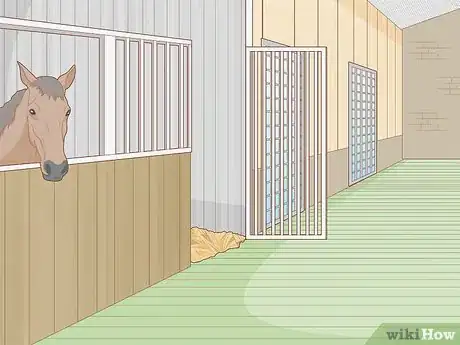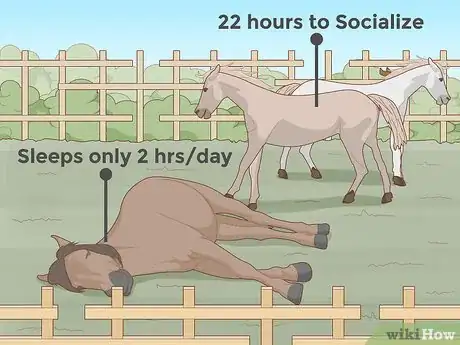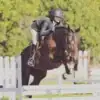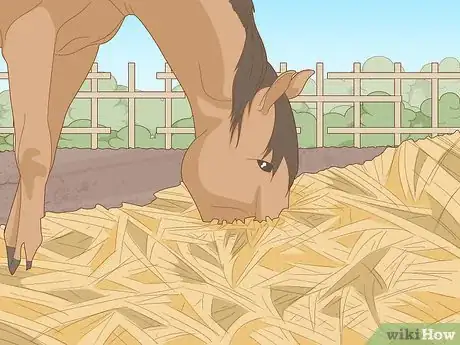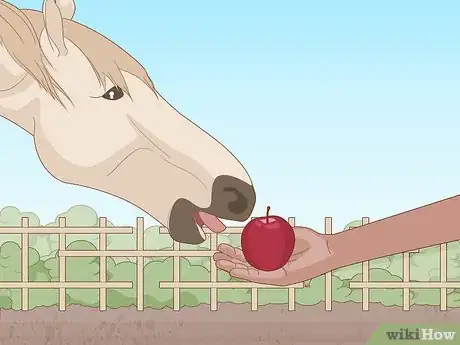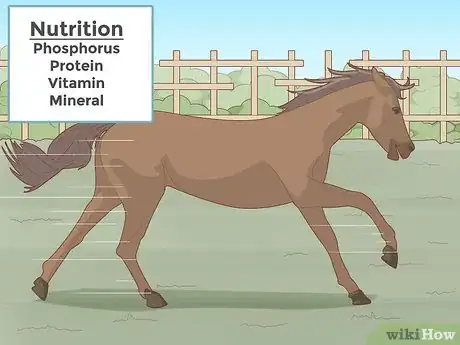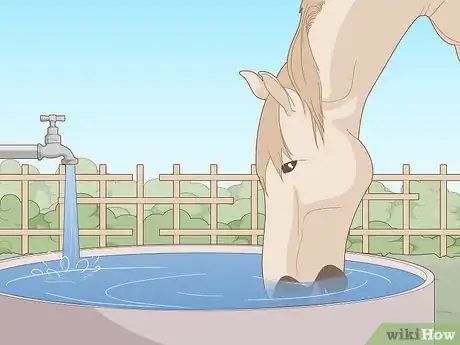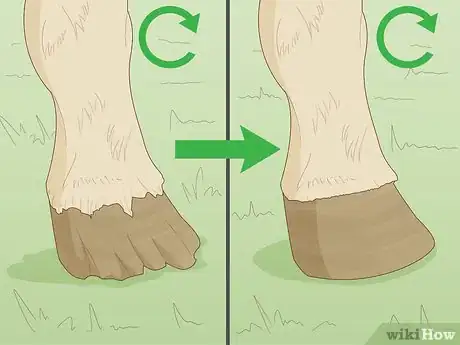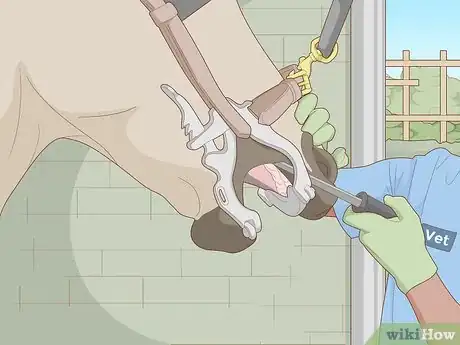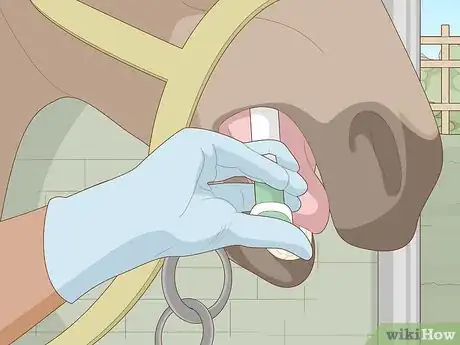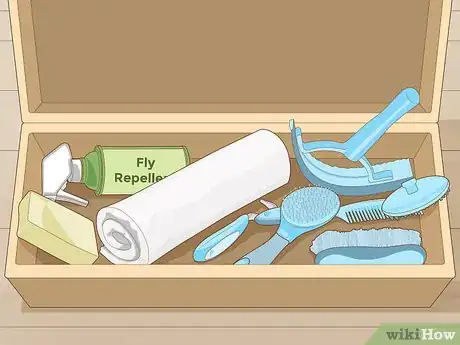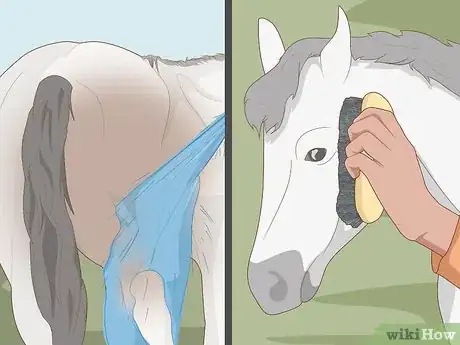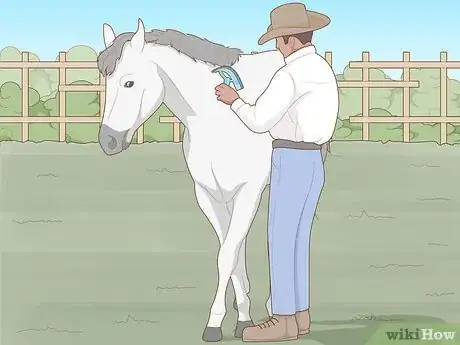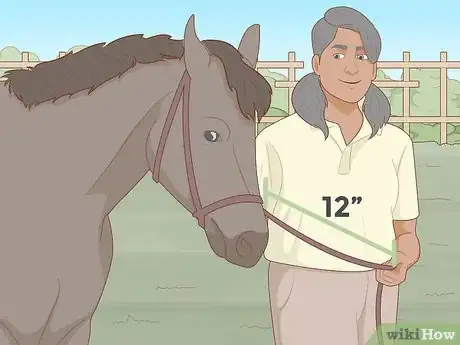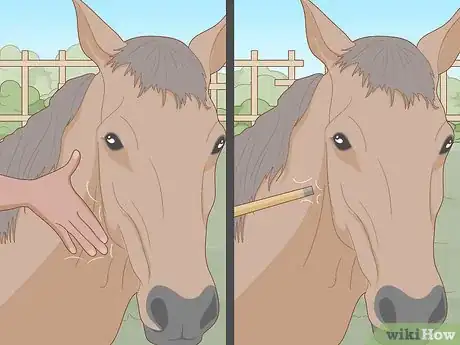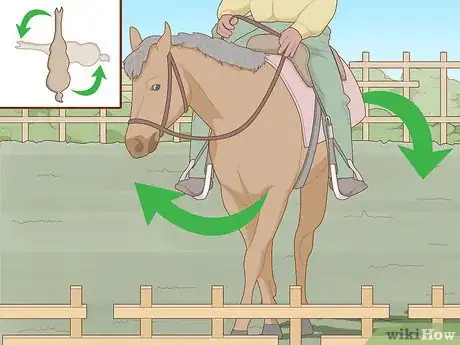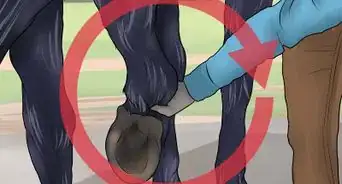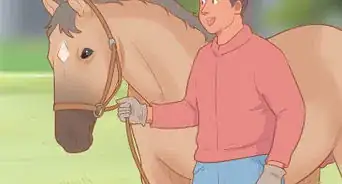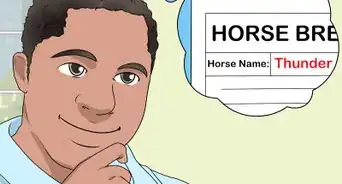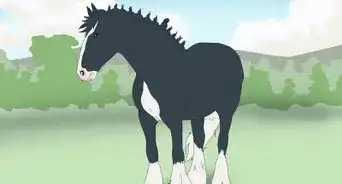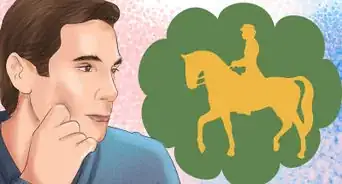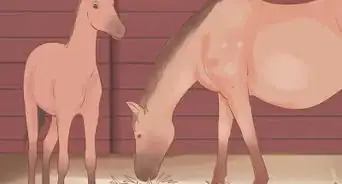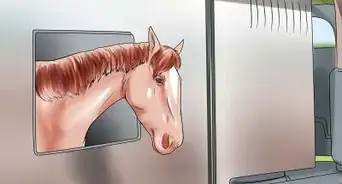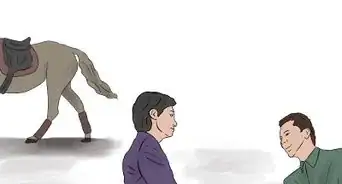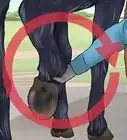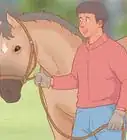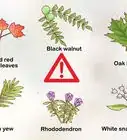This article was co-authored by Kate Jutagir. Kate Jutagir is an Equestrian Specialist, Hunter/Jumper Trainer, and the Owner of Blackhound Equestrian, a premier training barn located on 65 acres in Castro Valley, California. Originally designed to be a riding school used as a springboard for dedicated students into careers in the sport, Blackhound Equestrian has grown into a hunter/jumper training program for all levels focusing on providing a solid foundation needed for personal advancement in the sport. Kate has over 25 years of equestrian instruction and training experience. Her focus on developing horse and rider partnerships provides a complete equestrian education for both beginners and advanced riders alike.
There are 23 references cited in this article, which can be found at the bottom of the page.
This article has been viewed 54,057 times.
Raising your horse can bring you many years of close companionship with him. When raised properly and with care, your horse will see you as someone he can trust and depend on. As wonderful as it can be to own a horse, keep in mind that raising a horse takes a lot of love, care, and commitment [1] — not to mention money! If you are currently a horse owner, or are thinking about owning a horse, try to learn as much as you can about what it takes to raise a horse.
Steps
Housing a Horse
-
1Create a comfortable stall for your horse. Depending on how you will be using your horse (work or leisure), he could end up spending a good amount of time in his stall. It is very important that his stall is dry, safe, and comfortable.[2] For example, his stall should be in an area of the barn that is well-ventilated.[3]
- Good ventilation prevents water and dust accumulation that could affect your horse’s health.[4]
- Comfortable bedding options for the stall include dust-free wood shavings, hemp, and straw. Rubber matting topped with straw or wood shavings is another good option.[5]
- You can also create a multi-layered floor, consisting of a subfloor made of natural materials (e.g., crushed rock) that is paved over with concrete or asphalt, and a top floor made of either rubber or plastic.[6] This option is time consuming to install and could be expensive.
- You will need to ‘muck’ out your horse’s stall daily.[7] Mucking means cleaning out your horse’s manure with a shovel and wheelbarrow. You should also refresh the bedding and make sure it is spread evenly.[8]
-
2Provide your horse with outdoor shelter. When your horse is outside grazing, he should have a place to go where he can to protect himself from the elements. A sturdy, three-sided box stall can provide this kind of shelter. The box stall should have a waterproof roof and be positioned such that the back wall faces the wind.[9] [10]
- Your horse should be able to stand comfortably in the stall without bumping his head against its ceiling. It is best if you account for him raising his head high and even rearing, just in case.[11] If you have multiple horses, they should all be able to fit in the stall comfortably at the same time.[12]
- The box stall is especially important during the summer to give your horse relief from the shade and biting insects.[13]
- Clean the box stall daily.
- Consider talking with other horse owners or visiting your local home improvement store for assistance and guidance on constructing a box stall.
Advertisement -
3Remember that your horse was never meant to live in a stall. It is best to allow as much time in a pasture as possible, even overnight.[14] Horses only sleep for about two hours, leaving 22 hours left in the day to socialize! Even if you use your horse more for leisure than work, it is essential that you give him time outside of his stall to graze and stroll around in a paddock or pasture.[15] This outside time gives your horse a chance to exercise.[16] In general, about one acre of pasture is needed per horse, but the more space, the better.[17]
- The paddock or pasture should be enclosed by a sturdy fence,[18] such as a wire fence secured with strong wooden posts, a wooden rail fence, pvc fencing, or naturally woven brush and trees. Remember that wooden fences need to be sealed periodically and pvc fencing acquires mold that needs power-washing.[19] #* Do not use barbed wire fencing.[20] Your horse could seriously injure himself on barbed wire. Though it is safe for cattle, horses have thinner skin and are more likely to jump and land in it.
- There can be many hazards in your horse’s paddock or pasture, including poisonous plants (e.g., yew, foxglove, buttercups, oak leaves and acorns), trash, and holes in the fencing.[21] Check for these hazards at least once a week, and remove any that you see.
Feeding a Horse
-
1Give your horse plenty of grass and hay. Feeding a healthy, balanced diet is key to raising a horse. Grass and hay are staples of a horse’s diet.[22] Your horse’s digestive system, although sensitive,[23] can handle large quantities of water and fiber.[24] Grazing out in the pasture or paddock will meet your horse’s need for grass consumption.
- The hay should be free of dust and mold.[25] Dusty or moldy hay can damage your horse’s lungs and upset his stomach.
- Common types of hay include clover, alfalfa, timothy, and fescue.
- The type of hay you feed your horse can depend on his life stage and use. For example, an older horse who is living out his golden years will probably not need the same type of hay as a young, racing thoroughbred. Consult with your veterinarian throughout your horse’s life to ensure your horse is eating the ideal type and amount of hay.
- Your horse should have access to hay or grass all day. To keep him from wasting too much hay as he is eating, consider placing the hay in a hay feeder. It can also be spread out over rubber mats or grass. Hay that is spread out and fluffed up will keep horses occupied and prevent them from eating more than they meant to with tightly compacted food.
- Covering the hay and storing it in your barn can help prevent mold development and infestation of small vermin like rats or mice. Always check hay before feeding to catch any wire, string, or animals that could have become trapped during baling.[26]
- The average horse should eat about two to four percent of his body weight in hay or other feeds per day.[27]
-
2Limit the amount of grain you feed your horse. Grain is another component of a horse’s diet. Examples of good grains to feed your horse include oats, wheat bran, and ground ear corn.[28] Horses tend to prefer eating mixed grains, so provide a variety for your horse.[29]
- Be aware that grain is high in carbohydrates and cause serious health problems (colic, muscle disorders, joint problems in foals) if your horse eats too much of it.[30]
- A good rule of thumb is to start your horse on one-half pound of grain per 100 pounds (45 kilograms) body weight.[31] From there, you can work with your veterinarian to determine how much grain your horse will need, based on his age and activity level.
- Always feed your horse hay before grain. This will keep him from not only eating too much grain, but eating it too quickly.[32]
- Split the grain feeding into three to four small feedings per day.[33]
- You may have heard that you should feed your horse more grain in the winter to keep him warm. In actuality, hay produces more heat than hay does when digested.[34]
-
3Give your horse some treats. Your horse will enjoy receiving treats from you. In fact, giving him treats on a daily basis is an important part of his overall care.[35] However, giving him too many treats could mess up his diet and potentially cause him to want the treats more than his normal food.
- The treats you give your horse should be healthy. Examples of healthy treats include apples, maple syrup, carrots, watermelon, and honey. Feeding fruits and vegetables on a regular basis provides extra nutrition not available in grass and hay.[36]
- Be aware that hand-feeding treats to your horse may cause him to start nipping at you. This should not be a problem if you are a well-established leader and are aware of how to use body language to say "no".[37]
-
4Adjust your horse’s diet as he ages. Your horse’s nutritional needs will change as he gets older. It is important that you know how to make nutritional adjustments to maintain your horse’s good health throughout his life. If your horse is young, he will need a high amount of protein, vitamins and minerals in his diet.[38]
- A young horse will also need a higher ratio of concentrates to forage than older horses. The hindgut of a young horse is still developing and cannot handle the large amounts of fiber and water from grass and hay.[39] Talk with your veterinarian about how to balance the ratio of concentrates to forage in your young horse.
- Even though a young horse cannot eat as much grass or hay as an older horse, he should still have 24-hour access to a paddock or pasture. This will allow him to eat at his leisure and get exercise that is necessary for healthy bone development.[40]
- An older horse needs more phosphorus and protein in his diet to maintain good health and body condition. These nutrients should be given in an easily digestible form.[41] Talk with your veterinarian about how best to add more of these nutrients to your older horse’s diet.
-
5Provide your horse with unlimited access to water. The average horse will consume about eight gallons of water per day.[42] The water should be fresh and clean. Buckets and water troughs should be emptied and cleaned out regularly with a diluted bleach solution. Leaving water on a constant drip will also discourage bugs, mold, and fungi from staying there. The water must be regularly checked in case a bird or squirrel has drowned there.[43]
- Place a large bucket in your horse’s stall and fill it with water. To keep the bucket from tipping over when your horse drinks from it, consider placing it inside of an old tire or hanging it from the wall.[44]
- Check the bucket’s water level throughout the day and refill when necessary.
Maintaining a Horse’s Routine Care
-
1Get your horse’s hooves trimmed. Maintaining a schedule of routine care for your horse is another important component of raising him and keeping him healthy. If your horse’s hooves do not get trimmed down naturally by his daily activities, then they should be trimmed once every six to eight weeks, but no more than once a week.[45] Farriers (specialists in equine hoof care) are trained to trim hooves.
- If you want to save some money, you can learn how to trim your horse’s hooves on your own. However, you should first have a farrier or equine veterinarian show you how to do this properly and safely. You should be perfectly capable of filing down small chips and nicks, in either case.[46]
- On a daily basis, you should pick out each of your horse’s hooves to remove materials (e.g., rock, dirt, debris) that could get lodged in the hooves and cause pain and discomfort, especially before a ride. Think how you would feel going on a hike with sand in your socks or pebbles in your shoe![47] Ask your farrier or veterinarian if you are unsure how to do this.
- Horses are not born needing shoes, but they may be necessary if they have worn them for years. Truthfully, shoes are only needed if your horse will be walking on pavement or rocks every other day. Otherwise, shoes are needed only if there is some hoof injury that needs treatment. However, if your horse is more than a few years old and has been wearing shoes his whole life, he will have adjusted to them and should continue to be shoed regularly.
- In either case, your horse still needs their hooves trimmed to be sure they are able to walk properly and their hooves do not get major chips.
- Most horse shoes are made of aluminum or rubber.[48]
- Different shoes are used for different purposes. Your farrier or veterinarian can recommend what type of shoe would work best for your horse.[49]
-
2Schedule regular dental care for your horse. A healthy mouth is crucial to your horse’s overall health. Your horse’s teeth grow continually and can become uneven over time.[50] This unevenness can lead to sharp points on your horse’s teeth that can make it very painful and difficult for him to eat.[51] The sharp points are smoothed down in a process called ‘floating,’ which is done by either an equine veterinarian or equine dentist.[52]
- Your horse’s teeth should be floated once, but ideally twice, a year.[53]
- Teeth floating is hard work and requires that your horse be sedated. Do not attempt to float your horse’s teeth on your own.
- Poor dental care can lead to such health problems as colic, choke, and weight loss due to your horse’s inability to adequately chew his food. Uneven teeth can also cause ‘quidding’—food falling out of your horse’s mouth.[54]
- The angle of a horse’s teeth can change as he grows older. If you have an older horse, you should regularly check his teeth for unevenness.[55]
-
3Vaccinate and deworm your horse. Regular vaccinations and deworming, performed by your veterinarian, are essential to keeping your horse healthy as you raise him. All horses should receive a tetanus vaccination.[56] Depending on your location, your horse might need other vaccinations, such as rabies, equine influenza, and West Nile virus.[57]
- Your equine veterinarian will be able to tell you which other vaccinations your horse will need.[58]
- Regular deworming is important to keeping your horse’s worm burden as low as possible. Over time, a heavy worm burden can negatively affect your horse’s digestive system,[59] , cause weight loss, and worsen your horse’s coat condition.[60] Work with your veterinarian to set up a regular deworming schedule.
- In addition to deworming, you can do several things on your property to decrease the environmental worm burden: rotating which pastures your horse grazes in and regularly picking up his feces.[61] Talk with your equine veterinarian about how to do pasture rotation.
- If you have multiple horses, make sure that you do not overcrowd any one pasture area with horses.[62]
Grooming and Touching a Horse
-
1Purchase grooming supplies. Grooming your horse not only keeps his coat clean and healthy as he ages, but also gives you time to bond with him and check his body for any abnormalities (lumps, bumps, injuries).[63] You will need a number of supplies to groom your horse—make the investment to purchase good quality grooming supplies and replace them as needed. There are several types of brushes (e.g, dandy, body) and combs (e.g., curry, mane and tail) that you will need.[64]
- Dandy brushes are stiff bristled and are good for flicking dust off your horse’s coat.[65] Body brushes, which are soft bristled, are used to brush over your horse’s body.[66]
- Curry combs are rubber or metal. Rubber curry combs are for raising dust and dirt from your horse’s coat. The metal comb should not be used on your horse’s body—it is used to clean your other brushes.[67]
- Mane and tail combs are usually wide-toothed to glide through your horse’s mane and tail more smoothly.[68]
- A plain towel is good for giving your horse a final wipe down to remove any remaining dust or dirt after you’ve finished grooming him.[69]
- It is also good to own a sweat scraper to remove water after bathing and a special metal comb to remove hair during the shedding season.
- During the warmer months, it would be good to spray fly repellent on your horse after grooming.[70]
- Organize all of your supplies in a container, such as a bucket, cabinet, or trunk.[71]
-
2Groom your horse systematically. During your daily grooming sessions, groom your horse in the same way each time.[72] This will prevent you from forgetting to groom a certain part of his body. Many horse owners prefer to start at their horse’s head and groom back to the tail,[73] but you can choose whichever direction you’d like—just be consistent about it.
- Which brush and comb you use first will depend on how much dirt and dust is on your horse’s coat. If he is particular dirty, you’ll probably need to use a dandy brush and rubber curry comb first to remove the dirt and dust.
- Pay attention to your horse as you groom him. He may have areas on his body that he is not comfortable with you grooming. If he begins to tense up or step back, he is telling you that he doesn’t like where you are touching him. Leave that spot and move on to another part of his body, but be sure to return later during training to remove his fear. You must be able to check every part of your horse for soreness and injury.
-
3Touch your horse with different objects. In addition to becoming comfortable with grooming objects, your horse should also become accustomed to being touched with other objects, such as saddles, ropes, halters, and bridles.[74]
- Be gentle when touching and rubbing him with these different objects. It may take some time before he is comfortable with how they feel against his coat.[75]
- He should be comfortable with whichever objects you use with him, or put on him, on a regular basis.
Training a Horse
-
1Lead your horse. Raising your horse would not be complete without incorporating training into his overall care. When done properly, training your horse helps him trust and respect you, and feel safe with you.[76] Leading your horse is one way to train him.
- To lead your horse, you will need snug-fitting halter[77] and a lead rope (two to three meters long).[78]
- Leading your horse from his side is the customary position from which to lead.[79] It is also safer than leading him from the lead (in front of the horse) or drive (behind the withers) positions because he can see you on his side.
- Stand about 12 inches (30 cm) away from your horse and hold the lead rope in your right hand (without wrapping it around your hand).[80] [81] As you walk with him, establish and maintain your chosen distance from him.
-
2Train your horse to yield to pressure. Training your horse to yield to pressure, either direct or indirect, also teaches him to respect your personal space. He will know all about the subject if he has lived his life with other horses, but will not necessarily be used to the types of pressure you will provide. With direct pressure, you touch your horse with your hands. Indirect pressures involves the use of other driving aids, like a lead rope.
- Be gentle yet firm when applying direct pressure. Pick a particular part of his body, such as the shoulder, muzzle, or legs.[82] Apply steady pressure to that area, then release the pressure immediately when your horse moves away from it.[83]
- The direct pressure should be just enough to be uncomfortable to your horse.
- With indirect pressure, you will stand about three feet (one meter) in front of your horse with the lead rope attached to his halter. Point your index finger towards him and begin to wiggle the rope. Wiggle the rope with increasing force until your horse starts to move back, then stop.[84]
- It may take your horse a few tries before he understands how he is supposed to respond to pressure. The release of pressure is the reward, but you can also give him verbal praise and treats when he responds correctly.
-
3Teach your horse to turn on the forehand. Once your horse is comfortable with some of the more basic training, you can move forward with more advanced training, like turning on the forehand. Turning on the forehand requires your horse to shift his center of gravity to his back half and move his body to the side.[85] [86]
- This movement serves a few purposes: it allows your horse to stretch his muscles and gives you more control over his body.
- Learning this skill may be easier for your horse than for you.
- Training your horse to turn on the forehand involves you applying pressure with your legs to guide the movement of your horse’s hind legs while using the reins to control the movement of the front half of his body.
- It is important that you have just the right coordination between your legs and hands to control your horse’s movements. You will also need to make sure that you are sitting balanced on top of your horse.
Expert Q&A
-
QuestionHow do you keep a horse calm when beginning to train them?
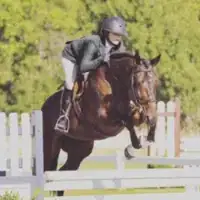 Kate JutagirKate Jutagir is an Equestrian Specialist, Hunter/Jumper Trainer, and the Owner of Blackhound Equestrian, a premier training barn located on 65 acres in Castro Valley, California. Originally designed to be a riding school used as a springboard for dedicated students into careers in the sport, Blackhound Equestrian has grown into a hunter/jumper training program for all levels focusing on providing a solid foundation needed for personal advancement in the sport. Kate has over 25 years of equestrian instruction and training experience. Her focus on developing horse and rider partnerships provides a complete equestrian education for both beginners and advanced riders alike.
Kate JutagirKate Jutagir is an Equestrian Specialist, Hunter/Jumper Trainer, and the Owner of Blackhound Equestrian, a premier training barn located on 65 acres in Castro Valley, California. Originally designed to be a riding school used as a springboard for dedicated students into careers in the sport, Blackhound Equestrian has grown into a hunter/jumper training program for all levels focusing on providing a solid foundation needed for personal advancement in the sport. Kate has over 25 years of equestrian instruction and training experience. Her focus on developing horse and rider partnerships provides a complete equestrian education for both beginners and advanced riders alike.
Equestrian Specialist & Trainer The best way to keep a horse engaged and calm would be to start from the ground up. Before you're even on their back, you want to set the parameters for your groundwork. That starts with working with your horse, moving forward with a halter on, leading them, and making sure that they understand your body cues and what you're asking them to do. As you get on the horse and start working with them, you want to make sure that you take the time at each and every speed to really define what you want.
The best way to keep a horse engaged and calm would be to start from the ground up. Before you're even on their back, you want to set the parameters for your groundwork. That starts with working with your horse, moving forward with a halter on, leading them, and making sure that they understand your body cues and what you're asking them to do. As you get on the horse and start working with them, you want to make sure that you take the time at each and every speed to really define what you want. -
QuestionWhat is the top horse raising country in the world?
 Community AnswerThe USA is the top horse raising country with a population of 10,350,000 horses.
Community AnswerThe USA is the top horse raising country with a population of 10,350,000 horses. -
QuestionWhat is the cost of a bit saddle and reins and a bridle?
 Community AnswerThere is a wide range of prices depending on what you are looking for. Western and English saddles cost anywhere from $500-$4000 new. Western headsets and English bridles can cost anywhere from $20-$300 new. Bits cost $10-$200 each and reins cost $10-$300.
Community AnswerThere is a wide range of prices depending on what you are looking for. Western and English saddles cost anywhere from $500-$4000 new. Western headsets and English bridles can cost anywhere from $20-$300 new. Bits cost $10-$200 each and reins cost $10-$300.
Warnings
- Horses can provide great companionship, but can also inflict serious injury. Do not let your guard down around your horse, and always have a plan to move to safety if he becomes agitated or frightened.⧼thumbs_response⧽
- Raising a horse is expensive. There is the initial cost of purchasing him, ongoing costs for food and various supplies, and veterinary expenses (routine and emergency). Do not commit to raising a horse if you are not financially able to do so for the long term.⧼thumbs_response⧽
- Certain plants (e.g, yew, buttercup, acorns, oak leaves) are toxic to your horse. Check the grazing areas regularly for any poisonous plants.[93] Speak with your veterinarian or visit your local gardening store to become for familiar with what the poisonous plants look like.⧼thumbs_response⧽
- Improper dietary habits (too much grain) and poor dental care can cause your horse to develop serious digestive problems.[94] [95] Feed him the right amounts of the right foods, and have his teeth floated at least once a year.⧼thumbs_response⧽
- Poorly fitting shoes can cause your horse to develop orthopedic problems in his legs. Hire an experienced farrier to put shoes on your horse’s hooves.[96]⧼thumbs_response⧽
References
- ↑ http://www.humanesociety.org/animals/horses/tips/horse_care_guidelines.html
- ↑ http://www.humanesociety.org/animals/horses/tips/horse_care_guidelines.html
- ↑ http://umaine.edu/livestock/equine/standards-for-the-housing-and-care-of-horses/
- ↑ http://umaine.edu/livestock/equine/standards-for-the-housing-and-care-of-horses/
- ↑ http://www.horses-and-horse-information.com/articles/horse-management.shtml
- ↑ http://www.thehorse.com/articles/10480/from-the-ground-up-stall-flooring-and-mats
- ↑ http://www.humanesociety.org/animals/horses/tips/horse_care_guidelines.html
- ↑ http://www.horses-and-horse-information.com/articles/horse-management.shtml
- ↑ http://umaine.edu/livestock/equine/standards-for-the-housing-and-care-of-horses/
- ↑ http://www.horses-and-horse-information.com/articles/horse-management.shtml
- ↑ http://umaine.edu/livestock/equine/standards-for-the-housing-and-care-of-horses/
- ↑ http://www.horses-and-horse-information.com/articles/horse-management.shtml
- ↑ http://www.humanesociety.org/animals/horses/tips/horse_care_guidelines.html
- ↑ Kate Jutagir. Equestrian Specialist & Trainer. Expert Interview. 31 March 2020.
- ↑ http://www.humanesociety.org/animals/horses/tips/horse_care_guidelines.html
- ↑ http://www.humanesociety.org/animals/horses/tips/horse_care_guidelines.html
- ↑ http://www.horses-and-horse-information.com/articles/horse-management.shtml
- ↑ http://www.humanesociety.org/animals/horses/tips/horse_care_guidelines.html
- ↑ http://www.horses-and-horse-information.com/articles/horse-management.shtml
- ↑ http://www.humanesociety.org/animals/horses/tips/horse_care_guidelines.html
- ↑ http://www.horses-and-horse-information.com/articles/horse-management.shtml
- ↑ https://www.aspca.org/pet-care/horse-care
- ↑ http://www.humanesociety.org/animals/horses/tips/horse_care_guidelines.html
- ↑ https://www.aspca.org/pet-care/horse-care
- ↑ http://www.humanesociety.org/animals/horses/tips/horse_care_guidelines.html
- ↑ http://www.horses-and-horse-information.com/articles/0899expense.shtml
- ↑ https://www.aspca.org/pet-care/horse-care
- ↑ http://www.aces.uiuc.edu/vista/html_pubs/horse/horse.html
- ↑ http://www.aces.uiuc.edu/vista/html_pubs/horse/horse.html
- ↑ https://www.aspca.org/pet-care/horse-care
- ↑ http://www.aces.uiuc.edu/vista/html_pubs/horse/horse.html
- ↑ http://www.equisearch.com/article/taking-care-of-horses-18682
- ↑ http://www.equisearch.com/article/taking-care-of-horses-18682
- ↑ https://www.aspca.org/pet-care/horse-care
- ↑ http://www.infohorse.com/healthytreats.asp
- ↑ http://www.infohorse.com/healthytreats.asp
- ↑ http://www.horsechannel.com/horse-community/horse-human-bond.aspx
- ↑ http://www.equisearch.com/article/feeding-older-and-younger-horses-10374
- ↑ http://www.equisearch.com/article/feeding-older-and-younger-horses-10374
- ↑ http://www.equisearch.com/article/feeding-older-and-younger-horses-10374
- ↑ http://www.equisearch.com/article/feeding-older-and-younger-horses-10374
- ↑ http://www.humanesociety.org/animals/horses/tips/horse_care_guidelines.html
- ↑ https://www.aspca.org/pet-care/horse-care
- ↑ http://www.horses-and-horse-information.com/articles/horse-management.shtml
- ↑ https://www.aspca.org/pet-care/horse-care
- ↑ http://www.horses-and-horse-information.com/articles/0899expense.shtml
- ↑ http://www.horses-and-horse-information.com/horseshoes.shtml
- ↑ http://www.horses-and-horse-information.com/horseshoes.shtml
- ↑ http://www.horses-and-horse-information.com/articles/horse-shoes.shtml
- ↑ https://www.aspca.org/pet-care/horse-care
- ↑ https://www.aspca.org/pet-care/horse-care
- ↑ https://www.aspca.org/pet-care/horse-care
- ↑ https://www.aspca.org/pet-care/horse-care
- ↑ https://www.aspca.org/pet-care/horse-care
- ↑ http://www.equisearch.com/article/feeding-older-and-younger-horses-10374
- ↑ https://www.aspca.org/pet-care/horse-care
- ↑ https://www.aspca.org/pet-care/horse-care
- ↑ https://www.aspca.org/pet-care/horse-care
- ↑ http://www.equisearch.com/article/feeding-older-and-younger-horses-10374
- ↑ https://www.aspca.org/pet-care/horse-care
- ↑ https://www.aspca.org/pet-care/horse-care
- ↑ https://www.aspca.org/pet-care/horse-care
- ↑ http://www.equisearch.com/article/grooming082497-18553
- ↑ http://www.equisearch.com/article/grooming082497-18553
- ↑ http://www.equusite.com/articles/basics/basicsGrooming.shtml
- ↑ http://www.equusite.com/articles/basics/basicsGrooming.shtml
- ↑ http://www.equisearch.com/article/grooming082497-18553
- ↑ http://www.equisearch.com/article/grooming082497-18553
- ↑ http://www.equisearch.com/article/grooming082497-18553
- ↑ http://www.equisearch.com/article/grooming082497-18553
- ↑ http://www.equisearch.com/article/grooming082497-18553
- ↑ http://www.equisearch.com/article/grooming082497-18553
- ↑ http://www.equisearch.com/article/grooming082497-18553
- ↑ http://www.equusite.com/articles/ground/groundRespect.shtml
- ↑ Kate Jutagir. Equestrian Specialist & Trainer. Expert Interview. 31 March 2020.
- ↑ Kate Jutagir. Equestrian Specialist & Trainer. Expert Interview. 31 March 2020.
- ↑ https://www.aspca.org/pet-care/virtual-pet-behaviorist/horse-behavior/teaching-your-horse-lead
- ↑ https://www.unce.unr.edu/publications/files/ag/other/fs9830.pdf
- ↑ http://www2.ca.uky.edu/agc/pubs/4af/4af05ma/4af05ma.htm
- ↑ https://www.aspca.org/pet-care/virtual-pet-behaviorist/horse-behavior/teaching-your-horse-lead
- ↑ http://nasdonline.org/1040/d000838/leading-horses-safely.html
- ↑ http://www.equusite.com/articles/ground/groundRespect.shtml
- ↑ http://www.equusite.com/articles/ground/groundRespect.shtml
- ↑ http://www.equusite.com/articles/ground/groundRespect.shtml
- ↑ http://www.horsechannel.com/english-horse-training/leg-yielding-tips-for-the-dressage-horse.aspx
- ↑ http://dressagetoday.com/article/id-simple-turn-forehand-benefits-16498
- ↑ http://www.humanesociety.org/animals/horses/tips/horse_care_guidelines.html
- ↑ https://www.aspca.org/pet-care/horse-care
- ↑ http://www.equisearch.com/article/feeding-older-and-younger-horses-10374
- ↑ http://www.horses-and-horse-information.com/articles/horse-management.shtml
- ↑ https://www.aspca.org/pet-care/horse-care
- ↑ https://www.aspca.org/pet-care/horse-care
- ↑ http://www.horses-and-horse-information.com/articles/horse-management.shtml
- ↑ https://www.aspca.org/pet-care/horse-care
- ↑ http://www.equisearch.com/article/feeding-older-and-younger-horses-10374
- ↑ http://www.horses-and-horse-information.com/horseshoes.shtml
About This Article
To raise a horse, you'll need a comfortable stall for it to live in, an outdoor shelter where it can graze, and a large pasture. Make sure you clean your horse's shelter daily and always stock it with grass, hay, grain, and fresh water. Additionally, groom your horse every day by brushing its coat and picking dirt out of its hooves. To bond with your horse and make training easier, touch it with saddles, ropes, halters, and bridles every day. For more advice from our Veterinary co-author, like what kind of veterinary care your horse needs, read on!
